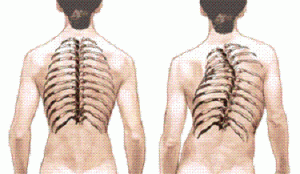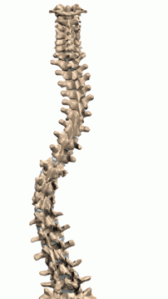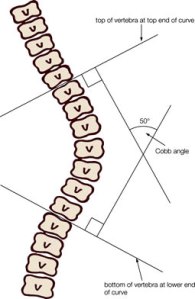 About Scoliosis
About Scoliosis
Definitions
SCOLIOSIS – is a three dimensional deformity of the spine and trunk. It is usually noted by the lateral deviation of the spine from the normal vertical line and measures greater than 10 degrees as noted by X-ray. This deviation is coupled with a flat tening of the spine in the sagittal plane (side view) and rotation of the vertebrae. The majority of scoliotic curves has an unknown origin and occurs most frequently in adolescents. When there is no evidence of underlying physical or radiographic pathology it is called Idiopathic Scoliosis. Congenital scoliosis is scoliosis that is present at birth due to failure of vertebrae to form or segment properly. Scoliosis can also occur due to neurological disorders.
tening of the spine in the sagittal plane (side view) and rotation of the vertebrae. The majority of scoliotic curves has an unknown origin and occurs most frequently in adolescents. When there is no evidence of underlying physical or radiographic pathology it is called Idiopathic Scoliosis. Congenital scoliosis is scoliosis that is present at birth due to failure of vertebrae to form or segment properly. Scoliosis can also occur due to neurological disorders.
Adolescent Scoliosis – a lateral spinal curvature that appears before the onset of puberty and before skeletal maturity that is diagnosed at age 10 or older. If origin is unknown it is known as Adolescent Idiopathic Scoliosis or AIS. 80-85% of scoliosis falls into this category. There may or may not be a genetic factor involved.
Adult Scoliosis – scoliosis of any cause which is present after skeletal maturity.
Infantile Scoliosis – a curvature of the spine that develops before 3 years of age.
Juvenile Scoliosis – scoliosis developing between the ages of 3 to 10.
COB B ANGLE – measures the lateral bend of the spine and is the universal standard to diagnose and assess scoliotic curve progression
B ANGLE – measures the lateral bend of the spine and is the universal standard to diagnose and assess scoliotic curve progression
RISSER SIGN– is used to evaluate skeletal and spinal maturity. It refers to the appearance of a crescent shaped line of bone formation on a regular x-ray which appears across the top of each side of the pelvis.
 SCOLIOMETER – a tool to measure trunk rotation. It works like a level.
SCOLIOMETER – a tool to measure trunk rotation. It works like a level.
Degrees of Scoliosis
Mild Scoliosis: 10-20° Cobb angle
High Mild-Low Moderate: 20-30° Cobb angle
Moderate to Severe: 30° or greater Cobb angle
Severe: 50° or greater Cobb angle
Some Additional Facts
![]() Scoliosis is not just one curve
Scoliosis is not just one curve
![]() Scoliosis affects the spine in 3 dimensions
Scoliosis affects the spine in 3 dimensions
![]() Scoliosis can affect height
Scoliosis can affect height
![]() Scoliosis can affect breathing capacity
Scoliosis can affect breathing capacity
![]() Scoliosis can affect appearance and well being
Scoliosis can affect appearance and well being
![]() The bigger the curve the greater the chance of progression
The bigger the curve the greater the chance of progression
![]() The younger the child the greater the chance of progression especially if there is good growth potential
The younger the child the greater the chance of progression especially if there is good growth potential
![]() Scoliosis can be treated at any age
Scoliosis can be treated at any age
![]() Statistics show that if a curve’s progression can be halted at 30° or less until growth is complete, the likelihood of curve progression in adulthood is reduced.
Statistics show that if a curve’s progression can be halted at 30° or less until growth is complete, the likelihood of curve progression in adulthood is reduced.
![]() Scoliosis is not life threatening and research shows surgery is rarely indicated
Scoliosis is not life threatening and research shows surgery is rarely indicated